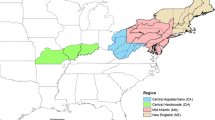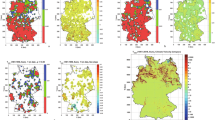Abstract
There is a need for biologically relevant metrics of climate risk for regional- to global-scale climate vulnerability assessments and adaptation planning. Here, we develop, combine, and compare univariate and multivariate forms of several metrics (climate-availability, climate-analog, and two forms of climate-velocity) used to assess the risks arising from future climate change, using downscaled climate projections for Wisconsin (USA) as a case study. Climate-availability and climate-analog analyses show little or no overlap between late-20th-century and projected late-21st-century climates for Wisconsin, and large differences among variables in the distance, bearing, and velocity of projected climate change. There is a strong negative correlation between geographic and climatic distances to closest analogs, creating a tradeoff when climate velocity is assessed using multivariate analog-based approaches: some locations have no good analogs anywhere in future climate space and so analog-based methods pick nearby locations, resulting in low velocity estimates. local velocities projected for Wisconsin are higher than global means. In this region, lake effects, not topographic heterogeneity, exert the strongest influences on regional patterns of climate-velocity and analogs. The multivariate analog-based velocities are correlated with univariate velocity measures that are scaled to local spatial heterogeneity, with the magnitude and correlation analog-based velocities estimates most similar to those of the intervariable mean of climate velocities. Because species are differentially sensitive to particular dimensions of climate change, and vary in their dispersal capacity, the strong differences among climate variables in the spatial direction, distance, and rate of projected climate change provide a powerful mechanism for community restructuring.





Similar content being viewed by others
References
Ackerly DD, Loarie SR, Cornwell WK, Weiss SB, Hamilton H, Branciforte R, Kraft NJB (2010) The geography of climate change: implications for conservation biogeography. Divers Distrib 16:476–487
Anderson MJ (2001) A new method for non-parametric multivariate analysis of variance. Austral Ecology 26:32–46
Burrough PA, McDonnell RA (1998) Principles of geographical information systems (Spatial Information Systems). Oxford University Press, New York
Burrows MT, Schoeman DS, Buckley LB, Moore P, Poloczanska ES, Brander KM, Brown C, Bruno JF, Duarte CM, Halpern BS, Holding J, Kappel CV, Kiessling W, O’Connor MI, Pandolfi JM, Parmesan C, Schwing FB, Sydeman WJ, Richardson AJ (2011) The pace of shifting climate in marine and terrestrial ecosystems. Science 334:652–655
Chen IC, Hill JK, Ohlemuller R, Roy DB, Thomas CD (2011) Rapid range shifts of species associated with high levels of climate warming. Science 333:1024–1026
Clark JS (1998) Why trees migrate so fast: confronting theory with dispersal biology and the paleorecord. Am Nat 152:204–224
Cleland EE, Chuine I, Menzel A, Mooney HA, Schwartz MD (2007) Shifting plant phenology in response to global change. Trends in Ecol Evol 22:357–365
Curtis JT (1959) The vegetation of Wisconsin. University of Wisconsin Press, Madison
Davis MB, Shaw RG (2001) Range shifts and adaptive responses to Quaternary climate change. Science 292:673–679
Dawson TP, Jackson ST, House JI, Prentice IC, Mace GM (2011) Beyond predictions: biodiversity conservation in a changing climate. Science 332:53–58
Dobrowski SZ, Abatzoglou J, Swanson AK, Greenberg JA, Mynsberge AR, Holden ZA, Schwartz MK (2012) The climate velocity of the contiguous United States during the 20th century. Global Change Biol:(In press)
García-Valdés R, Zavala MA, Araújo MB, Purves DW (2013) Chasing a moving target: projecting climate change-induced shifts in non-equilibrial tree species distributions. J of Ecol:n/a-n/a
Hijmans R, Cameron S, Parra J, Jones P, Jarvis A (2005) Very high resolution interpolated climate surfaces for global land areas. Int J Climatol 25:1965–1978
IPCC (2007) Climate Change 2007: Synthesis Report. In: Core Writing Team, Pachauri RK, Reisinger A (eds) Contribution of Working Groups I, II and III to the Fourth Assessment Report of the Intergovernmental Panel on Climate Change. IPCC, Geneva, Switzerland, 104 pp
Jackson ST, Betancourt JL, Booth RK, Gray ST (2009) Ecology and the ratchet of events: climate variability, niche dimensions, and species distributions. Proc Natl Acad Sci U S A 106:19685–19692
Loarie SR, Carter BE, Hayhoe K, McMahon S, Moe R, Knight CA, Ackerly DD (2008) Climate change and the future of California’s endemic flora. PLoS One 3:e2502
Loarie SR, Duffy PB, Hamilton H, Asner GP, Field CB, Ackerly DD (2009) The velocity of climate change. Nature 462:1052–1055
Maurer EP, Wood AW, Adam JC, Lettenmaier DP, Nijssen B (2002) A long-term hydrologically based dataset of land surface fluxes and states for the conterminous United States. J Clim 15:3237–3251
Nogues-Bravo D, Ohlemuller R, Batra P, Araujo MB (2010) Climate predictors of late Quaternary extinctions. Evolution 64:2442–2449
Notaro M, Lorenz DJ, Vimont D, Vavrus S, Kucharik C, Franz K (2011) 21st century Wisconsin snow projections based on an operational snow model driven by statistically downscaled climate data. Int J Climatol 31:1615–1633
Ohlemüller R (2011) Running out of climate space. Science 334:613–614
Ohlemüller R, Gritti ES, Sykes MT, Thomas CD (2006) Towards European climate risk surfaces: the extent and distribution of analogous and non-analogous climates 1931–2100. Glob Ecol Biogeogr 15:395–405
Parmesan C (2006) Ecological and evolutionary responses to recent climate change. Annu Rev Ecol Evol Syst 37:637–669
Parmesan C, Yohe G (2003) A globally coherent fingerprint of climate change impacts across natural systems. Nature 421:37–42
Pearson RG (2006) Climate change and the migration capacity of species. Trends Ecol Evol 21:111–113
Sandel B, Arge L, Dalsgaard B, Davies RG, Gaston KJ, Sutherland WJ, Svenning JC (2011) The influence of late Quaternary climate-change velocity on species endemism. Science 334:660–664
Saxon E, Baker B, Hargrove W, Hoffman F, Zganjar C (2005) Mapping environments at risk under different global climate change scenarios. Ecol Lett 8:53–60
Svenning JC, Skov F (2004) Limited filling of the potential range in European tree species. Ecol Lett 7:565–573
Thomas CD, Cameron A, Green RE, Bakkenes M, Beaumont LJ, Collingham YC, Erasmus BFN, de Siqueira MF, Grainger A, Hannah L, Hughes L, Huntley B, van Jaarsveld AS, Midgley GF, Miles L, Ortega-Huerta MA, Peterson AT, Phillips OL, Williams SE (2004) Extinction risk from climate change. Nature 427:145–148
Veloz S, Williams J, Lorenz D, Notaro M, Vavrus S, Vimont D (2012) Identifying climatic analogs for Wisconsin under 21st-century climate-change scenarios. Clim Chang 112:1037–1058
WICCI (2011) Wisconsin’s changing climate: impacts and adaptation. nelson institute for environmental studies. University of Wisconsin-Madison and the Wisconsin Department of Natural Resources, Madison
Wiken E, Jiménez Nava F, Griffith G (2011) North American Terrestrial Ecoregions—Level III. Commission for Environmental Cooperation, Montreal
Williams JW, Blois JL, Shuman BN (2011) Extrinsic and intrinsic forcing of abrupt ecological change: case studies from the late Quaternary. J Ecol 99:664–677
Williams JW, Jackson ST, Kutzbacht JE (2007) Projected distributions of novel and disappearing climates by 2100 AD. Proc Natl Acad Sci U S A 104:5738–5742
Woodall CW, Oswalt CM, Westfall JA, Perry CH, Nelson MD, Finley AO (2009) An indicator of tree migration in forests of the eastern United States. Forest Ecol Manage 257:1434–1444
Zhu K, Woodall CW, Clark JS (2012) Failure to migrate: lack of tree range expansion in response to climate change. Glob Chang Biol 18:1042–1052
Zuckerberg B, Woods AM, Porter WF (2009) Poleward shifts in breeding bird distributions in New York State. Glob Chang Biol 15:1866–1883
Acknowledgments
Wisconsin Focus on Energy and its Environment and Economic Research Program and the Bryson Climate, People, and Environment Program at the Nelson Institute Center for Climatic Research at the University of Wisconsin-Madison supported this work. We thank Drs. M. Notaro, D. Lorenz, and D. Vimont for advice and access to the WICCI datasets, and three anonymous referees for their useful comments that helped improve this manuscript. This is CCR publication Number 1074.
Author information
Authors and Affiliations
Corresponding author
Electronic supplementary material
Below is the link to the electronic supplementary material.
10584_2013_752_MOESM1_ESM.pdf
Appendix S1 Histogram of current and future (under the IPCC A1B, A2 and B1 scenarios) climatic availability for 19 bioclimatic variables. (PDF 32 kb)
10584_2013_752_MOESM2_ESM.pdf
Appendix S2 Histograms of the spatial distance and directional histograms (rose plots inserts) of the bearing between each Wisconsin grid cell and the North American grid-cell for 19 bioclimatic variables. (PDF 53 kb)
10584_2013_752_MOESM3_ESM.pdf
Appendix S3 Maps of spatial heterogeneity, temporal heterogeneity (under A1B, A2 and B1 scenarios) and the resulting velocity of climate change (km*y−1) for 19 evaluated bio-climatic variables. (PDF 2574 kb)
10584_2013_752_MOESM4_ESM.pdf
Appendix S4 PERMANOVA and PERANOVA of differences in climatic local velocities (multiple and univariate) of areas with and without climatic analogs. (PDF 130 kb)
10584_2013_752_MOESM5_ESM.pdf
Appendix S5 Association between the multivariate analog-based velocities (calculated as the spatial displacement of climate analogs between time intervals divided by the time step) and the univariate local velocities (PDF 180 kb)
10584_2013_752_MOESM6_ESM.pdf
Appendix S6 Association between the spatio-temporal displacements predicted based on climate analog contrasts (analog-based velocity) and local velocity estimates. (PDF 63 kb)
Rights and permissions
About this article
Cite this article
Ordonez, A., Williams, J.W. Projected climate reshuffling based on multivariate climate-availability, climate-analog, and climate-velocity analyses: implications for community disaggregation. Climatic Change 119, 659–675 (2013). https://doi.org/10.1007/s10584-013-0752-1
Received:
Accepted:
Published:
Issue Date:
DOI: https://doi.org/10.1007/s10584-013-0752-1




